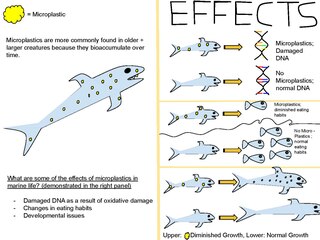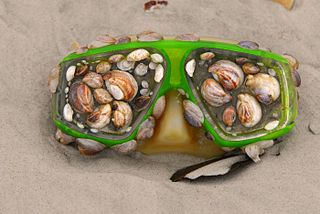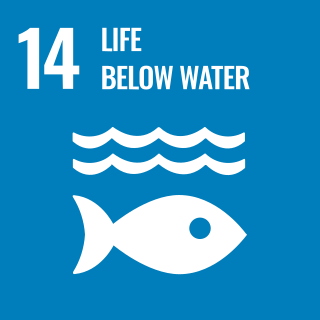Related Research Articles

Marine debris, also known as marine litter, is human-created waste that has deliberately or accidentally been released in a sea or ocean. Floating oceanic debris tends to accumulate at the center of gyres and on coastlines, frequently washing aground, when it is known as beach litter or tidewrack. Deliberate disposal of wastes at sea is called ocean dumping. Naturally occurring debris, such as driftwood and drift seeds, are also present. With the increasing use of plastic, human influence has become an issue as many types of (petrochemical) plastics do not biodegrade quickly, as would natural or organic materials. The largest single type of plastic pollution (~10 %) and majority of large plastic in the oceans is discarded and lost nets from the fishing industry. Waterborne plastic poses a serious threat to fish, seabirds, marine reptiles, and marine mammals, as well as to boats and coasts.

The Great Pacific garbage patch is a garbage patch, a gyre of marine debris particles, in the central North Pacific Ocean. It is located roughly from 135°W to 155°W and 35°N to 42°N. The collection of plastic and floating trash originates from the Pacific Rim, including countries in Asia, North America, and South America.

Plastic pellet pollution is a type of marine debris originating from the plastic particles that are universally used to manufacture large-scale plastics. In the context of plastic pollution, these pre-production plastic pellets are commonly known as 'nurdles'. These microplastics are created separately from the user plastics they are melted down to form, and pellet loss can occur during both the manufacturing and transport stages. When released into the open environment, they create persistent pollution both in the oceans and on beaches. About 230,000 tonnes of nurdles are thought to be deposited in the oceans each year, where they are often mistaken for food by seabirds, fish and other wildlife. Due to their small size, they are notoriously difficult to clear up from beaches and elsewhere.
A garbage patch is a gyre of marine debris particles caused by the effects of ocean currents and increasing plastic pollution by human populations. These human-caused collections of plastic and other debris, cause ecosystem and environmental problems that affect marine life, contaminate oceans with toxic chemicals, and contribute to greenhouse gas emissions. Once waterborne, marine debris becomes mobile. Flotsam can be blown by the wind, or follow the flow of ocean currents, often ending up in the middle of oceanic gyres where currents are weakest. Garbage patches grow because of widespread loss of plastic from human trash collection systems.

Marine plastic pollution is a type of marine pollution by plastics, ranging in size from large original material such as bottles and bags, down to microplastics formed from the fragmentation of plastic material. Marine debris is mainly discarded human rubbish which floats on, or is suspended in the ocean. Eighty percent of marine debris is plastic. Microplastics and nanoplastics result from the breakdown or photodegradation of plastic waste in surface waters, rivers or oceans. Recently, scientists have uncovered nanoplastics in heavy snow, more specifically about 3,000 tons that cover Switzerland yearly.

The Continuous Plankton Recorder (CPR) Survey is one of the longest running marine biological monitoring programmes in the world. Started in 1931 by Sir Alister Hardy and Sir Cyril Lucas, the Survey provides marine scientists and policy-makers with measures of plankton communities, coupled with ocean physical, biological and chemical observations, on a pan-oceanic scale. The Survey is a globally recognised leader on the impacts of environmental change on the health of our oceans.
OXO-biodegradation is plastic degradation by oxidation until its molecular weight is low enough to be accessed by bacteria and fungi who then recycle it back. Confusion is caused by use of the term "oxo-degradable", pro-degradant additive isn't put into plastic and marketedas oxo-biodegradable, and nobody would want it, if all it does is to create fragments of plastic. There is no "oxo-degradable" plastics industry. The scientific definitions are found in CEN Technical report CEN/TR 15351.

Plastics are a wide range of synthetic or semi-synthetic materials that use polymers as a main ingredient. Their plasticity makes it possible for plastics to be moulded, extruded or pressed into solid objects of various shapes. This adaptability, plus a wide range of other properties, such as being lightweight, durable, flexible, and inexpensive to produce, has led to its widespread use. Plastics typically are made through human industrial systems. Most modern plastics are derived from fossil fuel-based chemicals like natural gas or petroleum; however, recent industrial methods use variants made from renewable materials, such as corn or cotton derivatives.

The North Atlantic garbage patch is a garbage patch of man-made marine debris found floating within the North Atlantic Gyre, originally documented in 1972. A 22-year research study conducted by the Sea Education Association estimates the patch to be hundreds of kilometers across, with a density of more than 200,000 pieces of debris per square kilometer. The garbage originates from human-created waste traveling from rivers into the ocean and mainly consists of microplastics. The garbage patch is a large risk to wildlife through plastic consumption and entanglement. There have only been a few awareness and clean-up efforts for the North Atlantic garbage patch, such as The Garbage Patch State at UNESCO and The Ocean Cleanup, as most of the research and cleanup efforts have been focused on the Great Pacific garbage patch, a similar garbage patch in the north Pacific.

Microplastics are fragments of any type of plastic less than 5 mm (0.20 in) in length, according to the U.S. National Oceanic and Atmospheric Administration (NOAA) and the European Chemicals Agency. They cause pollution by entering natural ecosystems from a variety of sources, including cosmetics, clothing, food packaging, and industrial processes.

Plastic pollution is the accumulation of plastic objects and particles in the Earth's environment that adversely affects humans, wildlife and their habitat. Plastics that act as pollutants are categorized by size into micro-, meso-, or macro debris. Plastics are inexpensive and durable, making them very adaptable for different uses; as a result, manufacturers choose to use plastic over other materials. However, the chemical structure of most plastics renders them resistant to many natural processes of degradation and as a result they are slow to degrade. Together, these two factors allow large volumes of plastic to enter the environment as mismanaged waste and for it to persist in the ecosystem.

The plastisphere consists of ecosystems that have evolved to live in human-made plastic environments. All plastic accumulated in marine ecosystems serves as a habitat for various types of microorganisms, with the most notable contaminant being microplastics. There are an estimate of about 51 trillion microplastics floating in the oceans. Relating to the plastisphere, over 1,000 different species of microbes are able to inhabit just one of these 5mm pieces of plastic.
Abigail P. W. Barrows is an American marine research scientist and advocate based in Maine. Barrows directs microplastics research that is used to inform conservation-focused legislation, and she initiated the first baseline data map of microplastic pollution distribution in the waters off the coast of Maine.

Beach cleaning or clean-up is the process of removing solid litter, dense chemicals, and organic debris deposited on a beach or coastline by the tide, local visitors, or tourists. Humans pollute beaches with materials such as plastic bottles and bags, plastic straws, fishing gear, cigarette filters, six-pack rings, surgical masks and many other items that often lead to environmental degradation. Every year hundreds of thousands of volunteers comb beaches and coastlines around the world to clean this debris. These materials are also called “marine debris” or "marine pollution" and their quantity has been increasing due to anthropocentric activities.
Tamara Susan Galloway is a British marine scientist and Professor of Ecotoxicology at the University of Exeter. She was appointed an Officer of the Order of the British Empire in the 2019 Birthday Honours.

Chelsea Marina Rochman is an American marine and freshwater ecologist whose research focuses on anthropogenic stressors in freshwater and marine ecosystems. Since September 2016, Rochman has been an assistant professor at the University of Toronto in the department of Ecology and Evolutionary Biology and a scientific advisor to the Ocean Conservancy.

Jennifer F. Provencher is a Canadian conservation biologist. She is an early-career researcher and a spokesperson for the awareness of plastic contaminants in marine wildlife, pollution and climate change. Many of her work focus on the impact of human activities on the health of Arctic seabirds and marine ecosystems.

Sustainable Development Goal 14 is about "Life below water" and is one of the 17 Sustainable Development Goals established by the United Nations in 2015. The official wording is to "Conserve and sustainably use the oceans, seas and marine resources for sustainable development". The Goal has ten targets to be achieved by 2030. Progress towards each target is being measured with one indicator each.
Max Liboiron is a Canadian researcher and designer known for their contributions to the study of plastic pollution and citizen science.

The Mediterranean Sea has been defined as one of the seas most affected by marine plastic pollution.
References
- ↑ "2022".
- ↑ Buranyi, Stephen (31 December 2019). "The missing 99%: why can't we find the vast majority of ocean plastic?". The Guardian. ISSN 0261-3077 . Retrieved 2020-01-02– via www.theguardian.com.
- ↑ "Plastic pollution with Richard Thompson" on The Life Scientific, BBC Radio 4
- ↑ Thompson, Richard C.; Olsen, Ylva; Mitchell, Richard P.; Davis, Anthony; Rowland, Steven J.; John, Anthony W. G.; McGonigle, Daniel; Russell, Andrea E. (2004). "Lost at Sea: Where is All the Plastic?". Science. 304 (5672): 838. doi:10.1126/science.1094559. PMID 15131299. S2CID 3269482.
- ↑ Thompson, Andrea. "Earth Has a Hidden Plastic Problem—Scientists Are Hunting It Down". Scientific American. Retrieved 2020-01-02.
- ↑ "To Save the Oceans, Should You Give Up Glitter?". National Geographic News. 30 November 2017. Retrieved 2020-01-02.
- ↑ "Microplastic waste: This massive (tiny) threat to sea life is now in every ocean". The Independent. 13 July 2014. Retrieved 2020-01-02.
- 1 2 "Professor Richard Thompson OBE – University of Plymouth". www.plymouth.ac.uk. Retrieved 2020-01-02.
- ↑ Maps, University of Plymouth Drake Circus Plymouth Devon PL4 8AA United Kingdom +44 1752 600600; vacancies, directions Visit us Job. "International Marine Litter Research Unit team". University of Plymouth. Retrieved 2020-01-02.
- ↑ Richard Thompson on Twitter
- ↑ "World leader in microplastic research receives award from the Zoological Society of London". University of Plymouth. Retrieved 2020-01-02.
- ↑ "Marsh Christian Trust – Marsh Award for Marine and Freshwater Conservation". www.marshchristiantrust.org. Retrieved 2020-01-02.
- ↑ "Prestigious awards honour the stars of conservation science". British and Irish Association of Zoos and Aquariums . Retrieved 2020-01-02.
- ↑ "Professor Richard Thompson made an OBE for services to marine science". University of Plymouth. Retrieved 2020-01-02.
- ↑ "Richard Thompson". Royal Society. Retrieved 20 September 2020.
- ↑ "2022".
- ↑ https://www.af-info.or.jp/en/blueplanet/news/announcing-the-winners-for-2023-blue-planet-prize.html